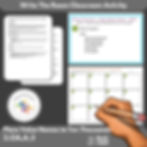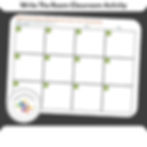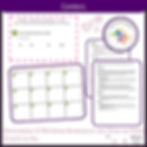Lesson plans for special education are very different than the general education counterpart. Special education lesson plans need to include missing skills and scaffolding for learners who have two or more years of deficits in learning standards-based lessons. Material and objectives vary student by student and must be differentiated.
Most importantly, special education lesson plans must be tailored to meet the IEP (Individualized Education Plan) goals for that particular student. Lesson plans must also include the student accommodations and modifications that will be used in the instruction.
In addition to individualized lesson plans, special education teachers need to keep data tracking systems for each student. This allows them to monitor student progress and update the IEP goals as needed. Differentiated instruction and data tracking are essential components of effective teaching for students with disabilities.
Without this customization, it would be very difficult for a teacher to provide an appropriate education for their students with special needs.
What are lesson plans for special education?
A lesson plan is a guide for teachers which outlines the specific details of a course or learning progression. Sometimes the learning progression is for an IEP goal or most often in support of general education standards-based instruction.
What is the difference between a general education lesson plan and a special education lesson plan?
A general education lesson plan is typically designed for all students in the classroom. A special education lesson plan must be differentiated to meet each student’s individual needs. This differentiation can include scaffolding material and objectives, accommodations, and modifications. It is important for all students to have lesson plans, but it is especially important for special education students who may need more scaffolding in order to be successful.
Why it's important to have lesson plans for special education
When it comes to teaching students with special needs, it's important that teachers have specific lesson plans in place. This ensures that all students are getting the instruction they need and that teachers are able to track the progress of each student. In addition, lesson plans help to create a consistent learning environment for students with special needs. By having well-developed plans in place, teachers can spend more time working with students one-on-one and provide the individualized attention they need.
What to think about before lesson planning?
Before creating a lesson plan, there are three key things to keep in mind:
Each of these factors plays an important role in helping to create an effective lesson plan.
A grade or skill level: This can help to ensure that the material is appropriate for the students. Skill level refers to the student's current abilities and understanding of the subject matter. When creating a lesson plan, it is important to consider the student's current level of mastery. This will help to ensure that the instruction is challenging enough, but not too difficult.
A specific objective: This states what the students will be able to do by the end of the lesson. Instructional objectives are specific goals that you want the student to achieve through the lesson. These objectives should be measurable, so you can determine if they were successfully met.
The material that will be covered: This outlines what topics will be addressed and how they will be covered. The material being covered refers to the specific topic or concept that will be taught during the lesson. It is important to select materials that are appropriate for the student's skill level and that will help achieve the instructional objectives.
When putting all these factors together, you can create a well-rounded lesson plan that is tailored to meet the needs of each individual student. This will help ensure that all students are able to learn and make progress in their studies.
| More hand-picked content you may find helpful: |
|
How to develop effective lesson plans for a special education classroom?
The first step in this process is to understand the individual needs of the students. This means carefully assessing each student and then designing lessons that target their specific needs. Once you have a good understanding of the students’ abilities, you can begin to develop appropriate lesson plans.
Start by assessing the students' skills and abilities. This will help you to determine what if any, modifications or accommodations need to be made.
Make sure that your objectives are clear and measurable. This will help you to track the students' progress and ensure that they are learning what they are supposed to.
Choose instructional materials that are appropriate for the student's level of ability. If necessary, modify or create your own materials to meet their needs.
Include a variety of activities and exercises in your plans, so that students stay engaged and interested in the lesson.
Be flexible and adaptable - things don't always go as planned, so be prepared to make changes on the fly.
10 components to an effective special education lesson plan
There are a few key components that all SPED lesson plans should have:
Lesson Entry Task: This is a task that students complete at the beginning of the lesson in order to activate their prior knowledge about the topic.
Instructional Objective: This states what the student will be able to do or know by the end of the lesson.
Materials Needed: This lists any materials that will be needed for the lesson, as well as any special information that the teacher needs to be aware of.
Differentiating Instruction Strategy: This is important for special education students, as it allows teachers to specifically adapt lessons to meet the needs of each individual student.
Instructional Strategies: This section outlines the specific methods that will be used during the lesson in order to help students learn.
Evaluation: This part of the plan allows teachers to track the progress of their students and see if they are meeting the objectives set forth in the lesson plan.
Group Activity/ Guided Learning: This allows teachers to provide students with more individual attention by splitting them into small groups.
Independent Work: This allows students to work on tasks at their own pace, with minimal teacher supervision.
Wrap up/Closing: This is the conclusion of the lesson, where students recap what they have learned and teachers assess their understanding.
Exit ticket: This is a question or task that students complete as they leave the classroom in order to assess their understanding of the lesson.
How lesson plans help teachers and students
Lesson plans help teachers by ensuring they cover all objectives for a specific topic. This helps to better teach the students and ensure they are on track. It can also help teachers plan their time more efficiently, as well as help identify any gaps in the curriculum. For special education students, lesson plans can be especially beneficial. They allow teachers to specifically tailor instruction to meet the student’s specific needs. This can help to improve the student’s academic progress and give them a better chance of succeeding at meeting their educational goals.
How to modify a lesson plan when needed
A teacher’s job is never done. Even when they think they have everything planned and under control, something can always come up that throws them off. For special education teachers, this is especially true. They not only have to plan lessons that meet their students’ needs, but they also have to be prepared for when things don’t go as planned.
One of the benefits of having a lesson plan is that it can be modified when needed. For example, if a student is absent, the teacher can modify the lesson to cover the material that was missed. Or, if a student is struggling with a particular concept, the teacher can modify the lesson to provide more support.
For a special education lesson plan, it is most important to have flexible timelines and objectives. This allows for more individual instruction and helps to ensure that all students are making progress.
Lesson plans should also always be aligned with the standards. This will help to make sure that you are covering all of the material that is important for your students.
While it is important to have a lesson plan, it is also important to be flexible. There will always be times when things don’t go according to plan. The best teachers are able to adapt and make changes on the fly. So, if something comes up, don’t worry, just go with the flow.
Lesson plans are important for all teachers, but they are especially important for special education teachers. They allow teachers to plan out specific details for their lessons in order to better teach the students what they need. It also helps to ensure that all students are on track and meeting the objectives for the course. Lesson plans should always be aligned with the standards so that you are covering all of the material that is important for your students.
Lesson plans should also be flexible so that they can be adapted to meet the needs of the students.
































